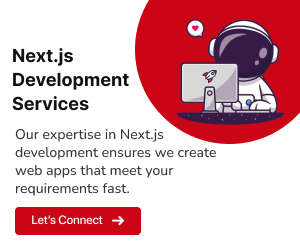In today’s digital age, web applications have become a cornerstone of business operations and customer engagement. When it comes to developing a web app, choosing the right technology stack is crucial. Next.js, a popular React framework, has gained immense popularity due to its performance and developer-friendly features. However, one critical question that often arises is, “How much does it cost to develop a Next.js app in the US?” In this blog post, we’ll explore the factors that influence the cost of developing a Next.js app in the United States.
In a landscape where user expectations are constantly evolving, creating a Next.js web application tailored to your specific business needs is not just about cost but also about investing in your digital presence. The cost estimation process can seem daunting, but by understanding the intricacies of the development journey and considering factors like scope, design, and development resources, you’ll be better equipped to make informed decisions and embark on a successful web app development venture. Let’s dive deeper into the key cost factors that can shape your Next.js app development journey in the US.
Exploring Next.js: A Robust Framework for Modern Web Development
In today’s fast-paced digital landscape, web applications are at the forefront of business operations and customer engagement. Selecting the right technology stack is paramount when it comes to developing a web app. Next.js, a popular React framework, has gained widespread acclaim for its impressive performance and developer-friendly features. In this blog post, we’ll delve into the world of Next.js, exploring its essential features and understanding why it’s a top choice for web developers.
Key Features of Next.js
Next.js offers a host of features that make it a go-to framework for building modern web applications
Server-Side Rendering (SSR):
Next.js enables SSR, which means that web pages are rendered on the server, providing faster initial loading times and better SEO optimization. This results in an enhanced user experience.
Automatic Code Splitting:
Next.js automatically splits code into smaller chunks, loading only what is necessary for a particular page. This optimizes performance and reduces load times, especially for larger applications.
Client-Side Routing:
The framework includes a client-side routing system, simplifying navigation within your application. This feature enhances the user’s interaction with your web app, making it feel more like a native application.
Zero Configuration:
Getting started with Next.js is a breeze, as it requires minimal configuration. This makes it an ideal choice for both beginners and experienced developers.
Styling Flexibility:
Next.js allows for flexible styling options, whether you prefer CSS-in-JS, traditional CSS, or other styling solutions. This gives developers the freedom to choose the approach that suits their project best.
Built-in CSS and Sass Support:
Next.js offers built-in support for CSS and Sass, making it easier to manage styles within your application.
Static Site Generation (SSG):
In addition to SSR, Next.js supports SSG, which generates static HTML at build time. This is beneficial for websites with content that doesn’t change frequently, as it further improves performance.
Optimized Image Loading:
Next.js optimizes image loading by providing features like automatic image optimization, lazy loading, and support for WebP formats. This helps reduce page load times and improve user experience.
API Routes:
The framework includes a simple way to create API routes, allowing you to build backend functionality directly within your Next.js application.
Active Community:
Next.js boasts a vibrant and active developer community, which means you can easily find solutions to common issues and access a wealth of resources for learning and development.

Cost Factors for Developing a Next.js App in the US
Now that we’ve covered the key features and considerations of Next.js, it’s time to address a critical question: How much should you budget for the development of a Next.js app in the United States? While providing a precise figure can be challenging without specific project details, we can provide you with a rough estimate that takes into account various factors influencing the overall cost. Keep in mind that this estimate is just a starting point and that project complexity and unique requirements can significantly impact the final cost. Let’s explore some cost considerations for developing a Next.js app in the US.
Project Scope and Complexity:
The complexity of your Next.js app plays a pivotal role in determining costs. A simple informational website might cost anywhere from $5,000 to $15,000, while a more intricate e-commerce platform or real-time data-intensive application could range from $20,000 to $100,000 or more.
Design and User Experience:
Design costs can vary significantly. Using pre-designed templates or themes may cost less, typically ranging from $1,000 to $10,000. However, for a custom design tailored to your brand and user experience, you might spend between $10,000 to $50,000 or even higher.
Development Team:
The choice of development resources greatly influences costs. In the US, experienced developers can charge hourly rates ranging from $50 to $200 or more. A basic Next.js app development project might take around 500-1000 hours, resulting in a development cost of $25,000 to $200,000.
Functionality and Features:
The more features and functionality your app requires, the higher the cost. Features like user authentication, payment processing, and integration with external services can significantly impact the budget. Basic features might add $5,000 to $20,000, while complex functionalities can exceed $50,000.
Third-party Integrations:
If your app needs to integrate with third-party services or APIs, you may incur additional costs, as some services require licensing fees. These expenses can range from a few hundred dollars to several thousand, depending on the integration complexity.
Testing and Quality Assurance:
Allocating a budget for thorough testing and quality assurance is vital. Expect to spend around 15-20% of your development budget on testing, which can be $5,000 to $40,000 or more.
Hosting and Infrastructure:
Hosting costs can vary based on the scalability and performance requirements of your app. For a small to medium-sized Next.js app, monthly hosting costs might range from $50 to $500 or more.
Maintenance and Updates:
Post-launch, your app will require ongoing maintenance and updates. Plan for these costs, which can be around 10-20% of your development budget annually.
Legal and Compliance:
Depending on your app’s nature, you might need to comply with various legal and regulatory requirements, such as GDPR or accessibility standards. Budget for legal consultation if necessary, which could be $2,000 to $10,000 or more.

Tips for Reducing the Cost of Developing a Next.js App
While developing a Next.js app in the United States involves various expenses, there are several strategies you can employ to help reduce costs without compromising on quality or functionality. Here are some valuable tips
Clear Project Scope:
Start with a well-defined project scope. Clearly outline the features and functionalities you need, and avoid scope creep during development. This prevents unnecessary costs associated with constantly expanding project requirements.Open Source Libraries:
Leverage open-source libraries and frameworks whenever possible. Many Next.js developers contribute to the open-source community, offering pre-built components and solutions that can save you time and money.
Minimalistic Design:
Opt for a clean and minimalist design that focuses on user experience. This can reduce design costs while still providing an aesthetically pleasing and functional interface.
Responsive Design:
Ensure your app is responsive to different screen sizes and devices. This can eliminate the need to develop separate mobile apps, saving both time and money.
Choose the Right Hosting:
Select a hosting provider and plan that aligns with your app’s requirements. Consider starting with a shared hosting plan and scaling up as your app grows to avoid overpaying for resources you don’t need initially.
Performance Optimization:
Invest in performance optimization from the beginning. Well-optimized apps require less server power and bandwidth, reducing hosting costs. Techniques like image optimization and lazy loading can significantly improve performance.
Efficient Code:
Write clean and efficient code to avoid performance bottlenecks and make future maintenance more cost-effective. Regularly refactor your code to ensure it remains efficient.
Continuous Integration and Deployment (CI/CD):
Implement CI/CD pipelines to automate testing and deployment processes. This reduces the risk of costly errors and streamlines development workflows.
Prototype and User Testing:
Before fully committing to development, create a prototype or minimum viable product (MVP) and conduct user testing. This helps identify potential issues early and saves costs on major revisions later.
Consider Serverless:
Explore serverless architecture for parts of your app that don’t require continuous server maintenance. Serverless solutions can be cost-effective for specific functionalities.
Outsourcing:
Consider outsourcing specific tasks, such as design or non-core development work, to skilled freelancers or agencies. This can help you access expertise without hiring full-time employees.
Long-term Planning:
Think about the long-term costs of maintaining and updating your app. Plan for ongoing maintenance and scalability to avoid unexpected expenses down the road.Optimize
Third-party Integrations:
If your app relies on third-party integrations, assess whether all of them are essential. Reducing the number of integrations can simplify development and reduce licensing costs.
Negotiate Licensing Fees:
When dealing with paid APIs or services, negotiate pricing based on your app’s usage. Some providers offer flexible pricing options that can save you money.
Documentation and Training:
Invest in comprehensive documentation and training for your development team. Well-documented code and training materials can reduce development time and minimize errors.
Is Next.js Worth the Investment? Evaluating the Value of Next.js for Web Development
When it comes to web development, the choice of the technology stack plays a pivotal role in the success of your project. Next.js, a React framework known for its performance and developer-friendly features, is often praised for its capabilities. However, as with any development tool, it’s essential to evaluate whether the benefits of Next.js justify the associated costs. Let’s delve into why Next.js is considered a valuable investment in web development.
Performance and User Experience:
One of the primary reasons why Next.js is worth the investment is its focus on performance and user experience. With server-side rendering (SSR) and automatic code splitting, Next.js enables faster page loading, which can lead to higher user engagement and better SEO rankings. Users tend to abandon slow-loading websites, making performance a critical factor in retaining and converting visitors.
Developer Productivity:
Next.js simplifies web development, allowing developers to concentrate on building features rather than dealing with complex configuration. Its zero-configuration setup, built-in routing, and support for hot reloading streamline the development process, ultimately reducing development time and costs.
SEO-Friendly:
Next.js excels in SEO optimization, which is crucial for the discoverability of your web app. SSR ensures that search engine bots receive fully rendered HTML content, improving your site’s ranking in search engine results pages (SERPs) without requiring additional SEO efforts.
Scalability:
Scalability is essential for web applications, especially if you expect your user base to grow. Next.js offers a straightforward path to scaling your app with minimal disruption, allowing you to expand your project as needed without incurring substantial redevelopment costs.
Vibrant Ecosystem and Community:
Next.js benefits from a vibrant and active developer community. This means you have access to a wealth of resources, documentation, and third-party libraries, reducing development time and troubleshooting efforts.
Cost-Efficient Hosting Options:
Next.js can be hosted on a variety of platforms, including serverless environments and traditional web hosting services. You can choose hosting solutions that align with your budget and the specific requirements of your app.
Reduced Maintenance Costs:
The framework’s focus on performance and best practices can lead to lower long-term maintenance costs. Well-optimized apps require fewer server resources, reducing hosting expenses, and efficient code can minimize the likelihood of costly bugs and issues.
Proven Track Record:
Next.js has been adopted by a wide range of companies, from startups to tech giants like Netflix, Airbnb, and Uber. Its success stories across various industries highlight its reliability and suitability for diverse web development projects.
Read More: Next.js vs React – What are the Differences?

Top Companies Offering Next.js App Development in the US
When considering the development of a Next.js app in the United States, partnering with the right development agency or company is crucial. Here are a few top companies known for their expertise in Next.js app development, with GeekyAnts leading the list:
1. GeekyAnts
GeekyAnts is a highly respected software development company specializing in Next.js app development. With a strong track record in building web and mobile applications, they are known for their commitment to quality and performance. GeekyAnts offers end-to-end services, from conceptualization and design to development and deployment, making them a top choice for clients seeking cutting-edge Next.js solutions.
2. ThoughtBot
ThoughtBot is a renowned design and development consultancy with a strong presence in the US. They specialize in creating user-centric web and mobile applications, including those built on Next.js. Their expertise in UX design and agile development practices makes them a preferred choice for clients seeking high-quality web applications.
3. DockYard
DockYard is a digital product agency known for delivering custom software, mobile, and web application development services. They have a dedicated team of Next.js developers skilled in building performant and scalable applications for various industries.
4. Netlify
Netlify is a popular hosting and automation platform that focuses on the JAMstack architecture, which includes Next.js. They offer a serverless environment for Next.js apps, making it easier to deploy and scale your projects while optimizing hosting costs.
5. Vercel
Vercel is the company behind Next.js and offers a comprehensive platform for developing and deploying Next.js applications. Their platform provides features like serverless functions, global CDN, and continuous integration, making it a go-to choice for developers building Next.js apps.
6. Rangle.io
Rangle.io is a digital transformation consultancy that specializes in modern web and mobile application development. They have a strong track record of delivering Next.js projects for clients looking to leverage the framework’s performance and scalability benefits.
7. Clevertech
Clevertech is a software development company that offers Next.js app development services. They focus on crafting custom digital solutions for startups and enterprises, ensuring that their clients’ web applications meet the highest standards of quality and efficiency.
8. Codal
Codal is a UX design and development agency with expertise in Next.js app development. They provide end-to-end services, from concept and design to development and maintenance, ensuring a seamless and successful project delivery.
9. ELEKS
ELEKS is a software development company with a global presence and a strong reputation in the US market. They offer Next.js app development services alongside a wide range of software solutions, making them a trusted partner for clients seeking advanced web applications.
10. Toptal
Toptal is a talent marketplace that connects clients with top software developers and designers. They have a network of highly skilled Next.js developers who can work on your project on a freelance or contract basis, offering flexibility and expertise.
Related: Top next.js app development companies in San franscisco
Conclusion
In conclusion, while the upfront costs of developing a Next.js app in the United States may vary depending on project complexity and specific requirements, the framework’s many advantages make it a worthwhile investment. Its performance improvements, developer-friendly features, and strong ecosystem contribute to cost savings in the long run, while also enhancing user experience and delivering a competitive edge in the digital landscape. When considering whether Next.js is worth the cost, it’s essential to weigh the potential benefits and ROI against your project’s unique needs and budget constraints.


























